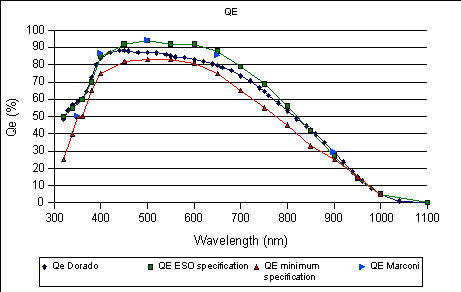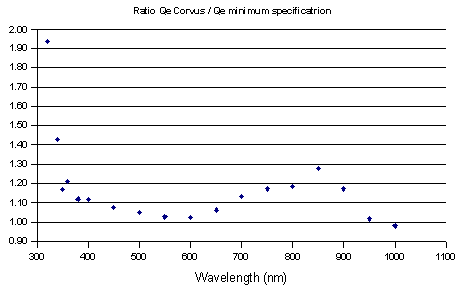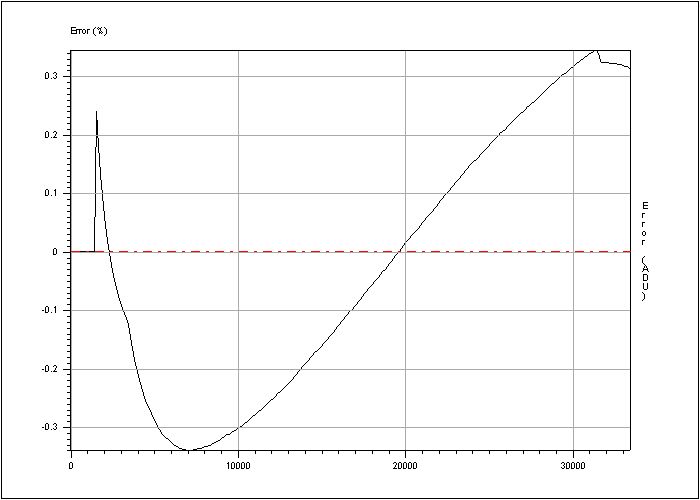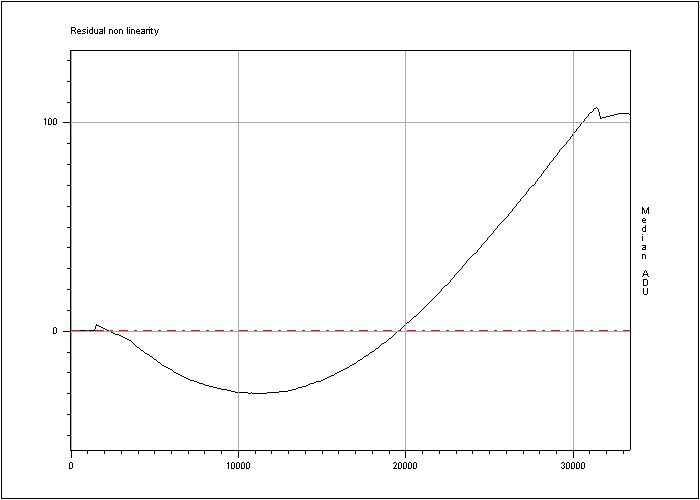

Figure 1: Comparison between the QE measured by ESO, the QE measured by Marconi, ESO specification and minimum specification.
Figure 2: Ratio between the ESO measurements and the ESO minimum specification.
Measurement made by the: 2001
Data reduced by Fabrice Christen
the: 4 September 2001
|
Wav. |
Qe Dorado |
Error |
PRNU RMS (%) |
Phase |
|
320 |
48.4 |
1.4 |
3.2 |
7.22 |
|
330 |
53.8 |
1.6 |
3 |
7.16 |
|
340 |
57.1 |
1.1 |
2.93 |
7.13 |
|
350 |
58.4 |
0.57 |
2.91 |
7.13 |
|
360 |
60.5 |
0.6 |
2.93 |
7.13 |
|
370 |
64.6 |
0.64 |
2.72 |
7.06 |
|
380 |
72.7 |
0.72 |
2.27 |
6.88 |
|
390 |
80.3 |
0.82 |
2.02 |
6.76 |
|
400 |
83.8 |
0.85 |
1.91 |
6.7 |
|
420 |
87 |
0.88 |
1.82 |
6.66 |
|
440 |
88.4 |
0.89 |
1.79 |
6.64 |
|
450 |
88.2 |
0.89 |
0 |
6.64 |
|
460 |
88 |
0.88 |
1.78 |
6.63 |
|
480 |
87.2 |
0.88 |
1.78 |
6.63 |
|
500 |
87.2 |
0.87 |
1.78 |
6.63 |
|
520 |
86.9 |
0.87 |
1.78 |
6.64 |
|
540 |
85.9 |
0.86 |
1.8 |
6.64 |
|
550 |
85.2 |
0.85 |
0 |
6.65 |
|
560 |
84.5 |
0.84 |
1.83 |
6.66 |
|
580 |
84.3 |
0.84 |
1.86 |
6.68 |
|
600 |
82.8 |
0.82 |
1.92 |
6.71 |
|
620 |
81.9 |
0.81 |
1.99 |
6.75 |
|
640 |
80.6 |
0.78 |
2.07 |
6.78 |
|
650 |
79.6 |
0.77 |
0 |
6.8 |
|
660 |
78.6 |
0.76 |
2.14 |
6.82 |
|
680 |
76.7 |
0.73 |
2.22 |
6.85 |
|
700 |
73.6 |
0.69 |
2.38 |
6.92 |
|
720 |
70.5 |
0.65 |
2.53 |
6.99 |
|
740 |
66.7 |
0.61 |
2.7 |
7.05 |
|
750 |
64.5 |
0.59 |
0 |
7.07 |
|
760 |
62.2 |
0.56 |
2.82 |
7.09 |
|
780 |
57.8 |
0.51 |
2.86 |
7.11 |
|
800 |
53.3 |
0.4 |
2.9 |
7.13 |
|
820 |
48.7 |
0.41 |
2.93 |
7.13 |
|
840 |
44.4 |
0.37 |
2.69 |
7.05 |
|
850 |
42.2 |
0.35 |
0 |
7.09 |
|
860 |
39.9 |
0.33 |
2.9 |
7.13 |
|
880 |
35 |
0.28 |
3.32 |
7.26 |
|
900 |
29.3 |
0.24 |
4.03 |
7.45 |
|
920 |
23.6 |
0.18 |
5.55 |
7.76 |
|
940 |
17.9 |
0.14 |
7.2 |
7.97 |
|
950 |
15.3 |
0.12 |
0 |
8.03 |
|
960 |
12.6 |
0.1 |
8.02 |
8.08 |
|
980 |
8.4 |
0.06 |
9.28 |
8.22 |
|
1000 |
4.9 |
0.04 |
9.88 |
8.28 |
|
1040 |
0.93 |
0.01 |
11.7 |
8.29 |
|
1100 |
0.13 |
0 |
35.3 |
8.69 |
Table 1: Measurement of the Quantum Efficiency.
In this section you can compare the QE we measured with the testbench and:
QE Minimum specification
Typical QE
QE from Marconi
|
|
|
|---|---|
Figure 1: Comparison between the QE measured by ESO, the QE measured by Marconi, ESO specification and minimum specification. |
Figure 2: Ratio between the ESO measurements and the ESO minimum specification. |
|
Special specification |
|||
|
Wavelength(nm) |
Minimum spec. (%) |
ESO measurements (%) |
Result |
|
350 |
50 |
58.4 |
OK |
|
400 |
80 |
83.8 |
OK |
|
650 |
80 |
79.6 |
Under the minimum spec. |
|
900 |
25 |
29.3 |
OK |
|
Conclusion: |
No, this CCD is not in the 25 % |
||
Table 2: Minimum specification for 25 % of the CCDs.
|
Comparison QE ESO and QE Marconi |
|||||
|
Wavelength (nm) |
QE ESO (%) |
Qe Marconi (%) |
Difference (Eso - Marc. %) |
Relative difference (Marconi as reference %) |
Ratio QE ESO / QE Marconi |
|
350 |
58.4 |
50.6 |
7.8 |
15.4 |
1.15 |
|
400 |
83.8 |
87 |
-3.2 |
-3.7 |
0.96 |
|
500 |
87.2 |
94.6 |
-7.4 |
-7.8 |
0.92 |
|
650 |
79.6 |
85.5 |
-5.9 |
-6.9 |
0.93 |
|
900 |
29.3 |
29.5 |
-0.2 |
-0.7 |
0.99 |
Table 3: Difference and relative difference between ESO measurements and Marconi.
|
|
|
|---|---|
Figure 3: Graphic representation of the difference and the relative difference. |
Figure 4: Ratio between the ESO measurements and the Marconi measurements |
In this section you can compare the PRNU we measured at ESO and:
PRNU Minimum specification
PRNU from Marconi
|
|
|
|---|---|
|
Figure 5: Comparison between the PRNU measured by ESO, the PRNU measured by Marconi, and the maximum specification. |
Figure 6: Ratio between the ESO measurements and the Maximum specification. |
|
|
|
|
Figure 7: Graphic representation of the difference and the relative difference. |
Figure 8: Ratio between the ESO measurements and the Marconi measurements. |
|
Comparison QE ESO and QE Marconi |
||||||
|
Wavelength (nm) |
PRNU ESO (rms %) |
Maximum spec. |
PRNU Marconi |
Difference (ESO – Marc.) |
Relative difference (Marc. as reference) |
Ratio PRNU ESO / PRNU Marconi |
|
320 |
3.2 |
6 |
0 |
0 |
0 |
0 |
|
350 |
2.91 |
5 |
3.3 |
-0.39 |
-11.82 |
0.88 |
|
400 |
1.91 |
2.5 |
1.2 |
0.71 |
59.17 |
1.59 |
|
500 |
1.78 |
2 |
0.9 |
0.88 |
97.78 |
1.98 |
Table 4: Difference and relative difference between ESO measurements and Marconi.
In this section you will see the if the values we have measured for the QE and the PRNU are in accordance with the contract.
|
Wavelength (nm) |
Qe |
PRNU |
|
320 |
OK |
OK |
|
340 |
OK |
|
|
350 |
OK |
OK |
|
360 |
OK |
|
|
380 |
OK |
|
|
400 |
OK |
OK |
|
450 |
OK |
OK |
|
500 |
OK |
OK |
|
550 |
OK |
|
|
600 |
OK |
|
|
650 |
OK |
|
|
700 |
OK |
|
|
750 |
OK |
|
|
800 |
OK |
|
|
850 |
OK |
|
|
900 |
OK |
|
|
950 |
OK |
|
|
1000 |
Below the specification |
|
Table 5: Comparison between the values we have measured and the specifications in the contract.
For the flat field we use three wavelengths, 350 nm, 600 nm and 900 nm. For each wavelength we make two images, high level (45000 ADU) and low level (1000 ADU).
350nm (UV), bandwidth 5nm |
600nm, bandwidth 5nm |
900nm, bandwidth 5nm |
|||
High level |
Low level |
High level |
Low level |
High level |
Low level |
Table 6: Flat field for three wavelengths.
The time exposure, for the long dark exposure, is 3600 seconds.
Table 7: Bias and dark.
Remark: As you can see on the dark image we have on this CCD some electroluminescence (two white spots below).
Clock mode: 225kpx/rr/HG/512 CCD Dorado, right port Conversion Factor= 0.53085e-/ADU ±0.001825 for 20491.2ADU RMS noise = 3.9575e- ±0.1876 CCD Dorado, left port Conversion Factor= 0.51719e-/ADU ±0.002056 for 20425.3ADU RMS noise = 3.4704e- ±0.17 Clock mode: 50kpx/rlrl/HG/512 CCD Dorado, left port Conversion Factor= 0.50531e-/ADU ±0.001956 for 19851.6ADU RMS noise = 2.7981e- ±0.1402 CCD Dorado, right port Conversion Factor= 0.51431e-/ADU ±0.002722 for 19679.4ADU RMS noise = 3.3139e- ±0.4088
RMS non linearity (%) = 0.23 Peak to peak non linearity (%)= 0.68

Figure 9: Error of linearity

Figure 10: Residual non linearity.
Exposure time (s) = 3600 Dark current : 1.67 ± 0.05 ADU/hour/pixel Dark current : 0.94 ± 0.03 e-/hour/pixel
Low level (Around 2500 ADU) Horizontal CTE = Vertical CTE = High level (Around 25000 ADU) Horizontal CTE = Vertical CTE =
In this section we expose the hot pixel, the dark pixel, the trap and the very large trap we found.
A hot pixel provides a signal of > 60 e- / pixel / hour.
Result: 48 hot points.
a very bright pixel provides a signal of > 200000 e-/pixel/hour
Result: 0 very bright pixel.
A dark pixel is one with 50% or less than the average output for uniform intensity light level, measured with a flat field level around 500 photo-electrons.
Result: 0 dark pixels detected.
A trap is defined as a pixel that captures more than 10 electrons, measured with a flat field level around 500 photo-electrons.
Result: 3 trap
A very large trap is defined as a pixel that captures more than 10 000 electrons, measured with a flat field level around 90% of full well capability.
Result: 16 very large trap.
Remark: These 16 points are
gathered into two groups like on this image:
![]()
A bad column is 10 or more contiguous hot or dark pixels in a single column or a very bright pixel or a very large trap.
Result: 1 bad columns.
Here is a summary of cosmetic defects:
|
|
Hot pixel |
Dark pixel |
A very bright pixel (a) |
Trap |
Very large trap (b) |
Sup. 10 contiguous pixels (c) |
Total bad column (a+b+c) |
|---|---|---|---|---|---|---|---|
|
ESO |
48 |
0 |
0 |
3 |
16 |
0 |
16 |
|
Marconi |
64 |
11 |
1 |
0 |
0 |
11 |
|
Table 8: Summary of cosmetic defects.
Back to the overview page ESO Test Reports for the OmegaCAM CCDs